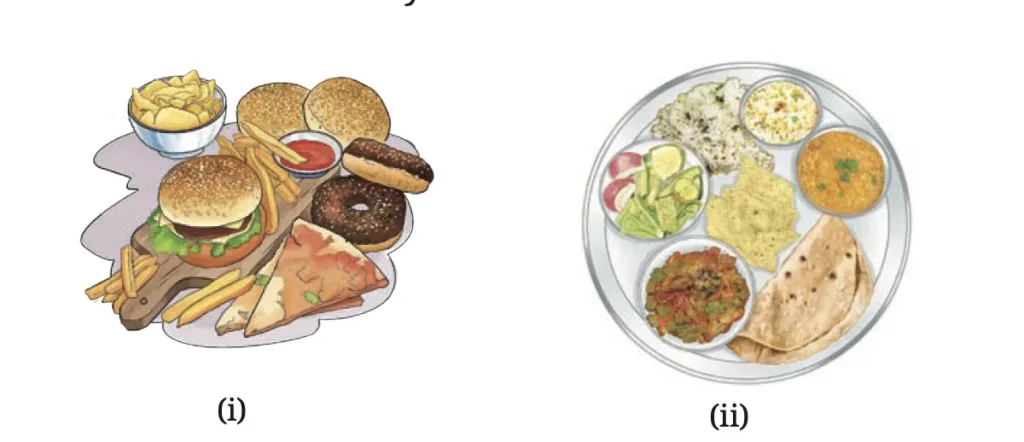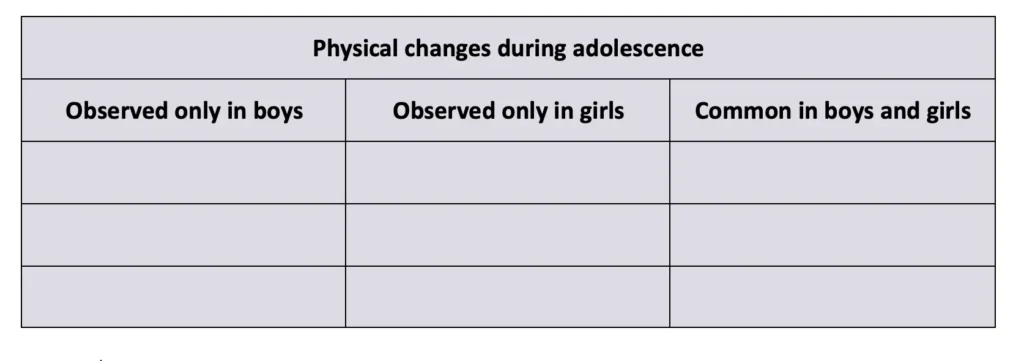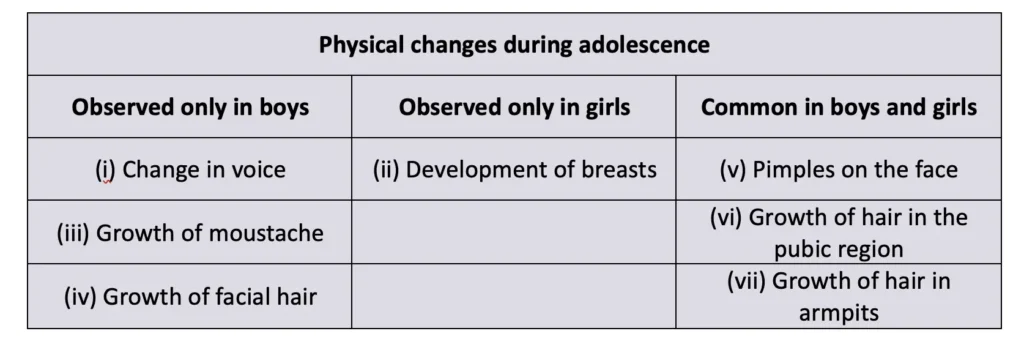Class 7 Science Curiosity Chapter 6 Adolescence: A Stage of Growth and Change NCERT Solutions
Let Us Enhance Our Learning (Page 85 – 87)
1. Ramesh, an 11-year-old boy, developed a few pimples on his face. His mother told him that this is because of ongoing biological changes in his body.
(i) What could be the possible reasons for the development of these pimples on his face?
(ii) What can he do to get some relief from these pimples?
Answer:
(i) The development of pimples on his face is due to increased oil secretion from the skin during adolescence. This excess oil, along with dust and dead skin cells, clogs the skin pores and leads to pimples.
(ii) To get some relief from these pimples, he can:
1. Avoid touching or pricking the pimples, as this can worsen the infection and cause scars.
2. Wash his face regularly with a mild soap or gentle cleanser.
3. Drink plenty of water to keep the skin hydrated.
4. Eat a healthy diet rich in fruits and vegetables.
2. Which of the following food groups would be a better option for adolescents, and why?

Answer:
The food group (ii) would be a better option for adolescents because it includes vegetables, pulses, salads, grains, and dairy products. These foods are good sources of carbohydrates, proteins, fats, vitamins, and minerals, which are essential for the growth, development, and overall health of adolescents.
3. Unscramble the underlined word in the following sentences:
(i) The discharge of blood in adolescent girls, which generally occurs every 28–30 days is nstmnoiaretu.
(ii) The hoarseness in the voice of adolescent boys is due to enlarged iceov xob.
(iii) Secondary sexual characteristics are natural signs that the body is preparing for adulthood and mark the onset of urtypeb.
(iv) We should say NO to lahoclo and srugd as they are addictive.
Answer:
(i) nstmnoiaretu → menstruation
(ii) iceov xob → voice box
(iii) urtypeb → puberty
(iv) lahoclo → alcohol
srugd → drugs
4. Shalu told her friend, “Adolescence brings only physical changes, like growing taller or developing body hair.” Is she correct? What would you change in this description of adolescence?
Answer:
Shalu is not completely correct because adolescence is not only about physical changes like growing taller, developing body hair, or changes related to reproductive capability. It also includes emotional, mental, and behavioural changes.
5. During a discussion in the class, some of the students raised the following points. What questions would you ask them to check the correctness of these points?
(i) Adolescents do not need to worry about behavioural changes.
(ii) If someone tries a harmful substance once, they can stop anytime they want.
Answer:
(i) Adolescents do not need to worry about behavioural changes.
👉 Question: Do behavioural changes during adolescence affect relationships, studies, or emotional health? Shouldn’t adolescents learn how to manage these changes properly?
(ii) If someone tries a harmful substance once, they can stop anytime they want.
👉 Question: Is it really easy to stop using harmful substances once tried, or can they cause addiction and long-term health problems?
6. Adolescents sometimes experience mood swings. On some days, they feel very energetic and happy, while on other days, they may feel low. What other behavioural changes are associated with this age?
Answer:
Some behavioural changes associated with adolescence are:
(i) Increased curiosity and interest in the opposite sex.
(ii) More independent thinking and decision-making.
(iii) Developing a sense of identity and self-awareness.
(iv) Experiencing stress, anxiety, or confusion due to rapid changes in body and mind.
(v) Developing a deep interest in new areas.
7. While using a toilet, Mohini noticed that used sanitary pads were scattered near the bin. She got upset and shared her feelings with her friends. They discussed the importance of menstrual hygiene and healthy sanitary habits. What menstrual hygiene and sanitary habits would you suggest to your friends?
Answer:
Some menstrual hygiene and sanitary habits one should follow:
(i) Use clean sanitary pads, reusable cloth, or menstrual cups during periods.
(ii) Change sanitary pads at regular intervals after every 4-5 hours or as per requirement.
(iii) Maintain the cleanliness of the genital area to avoid infections.
(iv) Wash hands thoroughly with soap after changing pads
(v) Wrap sanitary pads in newspaper before disposing of them in a covered dustbin.
(vi) Never throw pads in open spaces or drains.
8. Mary and Manoj were classmates and good friends. On turning 11, Mary developed a little bulge on the front of her neck. She visited the doctor who gave her medication and asked to take iodine-rich diet. Similarly, a bump was developed on the front of Manoj’s neck when he turned 12. However, the doctor told him that it was a part of growing up. According to you, what could be the possible reason for advising Mary and Manoj differently?
Answer:
The doctor advised Mary to take medication and an iodine-rich diet because she had developed a condition called goitre. Goitre is caused by iodine deficiency and results in the enlargement of the thyroid gland.
The doctor advised Manoj differently because the bump in his neck was due to the development of the voice box (larynx), which is a normal change observed in adolescent boys.
9. During adolescence, the boys and girls undergo certain physical changes, a few of which are given below.
(i) Change in voice
(ii) Development of breasts
(iii) Growth of moustache
(iv) Growth of facial hair
(v) Pimples on the face
(vi) Growth of hair in the pubic region
(vii) Growth of hair in armpits
Categorise these changes in the table given below:

Answer:

